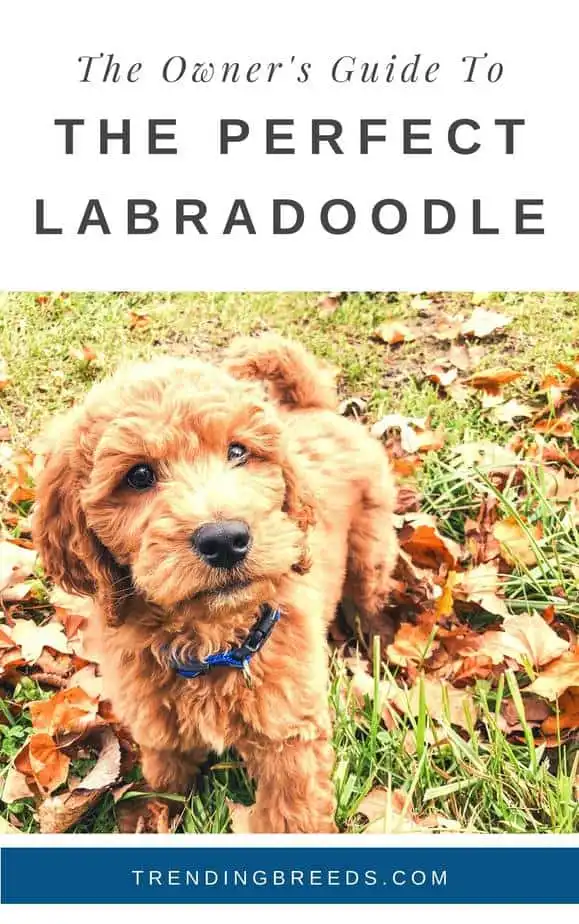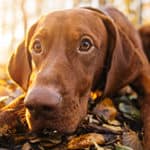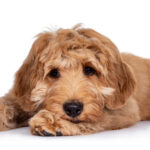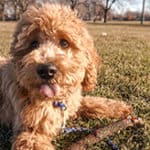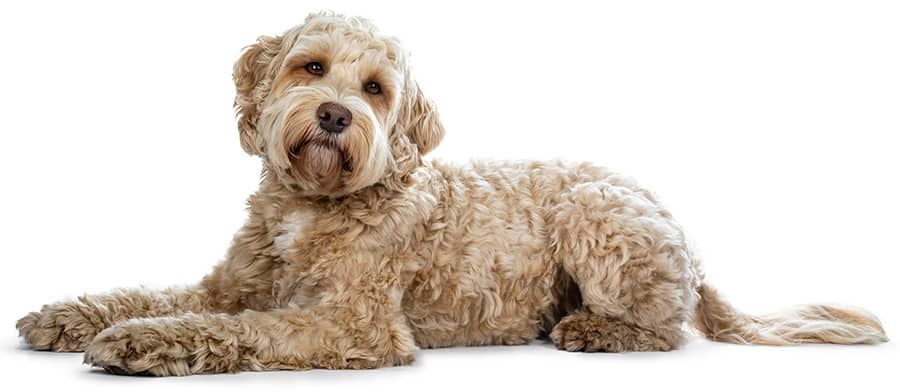
When most people hear ‘Labradoodle’, an image of a teddy bear-like dog pops in their head. Caring for that beautiful coat is relatively easy and we’ve broken it down into 7 steps for you so you can see what all it entails.
1. Brush/Comb Regularly
Brushing or combing your Labradoodle regularly plays a significant role in the overall health of their coat and the bond you have with them. We recommend at least 3 times a week. When you brush them, you’re doing a few things.
First, you’re helping to remove any tangles they might have. And, as we talk about in more detail here, tangles that don’t get the attention they need, quickly turn into painful mats in Labradoodles.
As your Labradoodle get older and their coat transitions from their puppy coat to their adult coat, the brushing helps pull/remove their puppy coat to make way for their adult coat. During this time, they are extremely likely to mat without being brushed.
You might notice that after you brush your pup, their coat seems much smoother and has a great shine to it. That’s because brushing brings out, and spreads, the natural oils that they have in their coat. The oils help protect their coat from damage and breakage, just as they do with human hair.
Brushing also gives you a chance to look over your dogs more closely; checking their skin, ears, and nails. Finding dry patches, cuts, or even ticks early on can prevent minor issues from escalating into something much worse.
2. Use Quality Shampoos And Conditioners
The shampoo and conditioner you use will make or break your Labradoodle’s coat and skin. It’s by far one of the most important areas to understand, so I can’t stress the importance of quality shampoo and conditioner enough.
Shampoo
It was recommended to us early on to use a soap-free and alcohol-free shampoo that also contained natural conditioners. Alcohol is harsh on their coat and skin, breaks down the natural oils they have, and really drys them out. Shampoo containing soaps causes build-up on their fur and gives them a nasty feel.
A shampoo like Earthbath’s line, has natural moisturizers built-in. But you may want to use a separate conditioner with similar ingredients, making sure it’s also alcohol-free . That’s what we do.
Conditioner
We use a detangler and conditioner, called Cowboy Magic Detangler and Shine, that was originally formulated to be used on the tails and manes of show horses. It makes brushing so much easier, smells great, and can be used on both wet and dry fur. It’s a concentrate, so a little goes a long way!
3. Avoid Using Heat To Dry Them
Many opt for using a human blow dryer, with heat, to dry their Labradoodle after bathing them. We don’t recommend that for 2 reasons.
First, it can be unsafe to use heated air to dry your pup. To do so without burning their coat or skin, you need to keep the blow dryer a certain distance away from them and keep the dryer in motion. If you don’t, you risk one area getting too hot and burning your pup.
Next, even if you are able to avoid overheating them, the hot air dries out their coat by removing their natural oils and the moisturizers you’ve applied during bathing them.
We use the old towel-dry method. Labradoodles, by the nature of their coat, tend to dry pretty quickly as it is. Just make sure you have plenty of towels, pat them down right after they come out of the bath, and give them a quick brushing to prevent tangles after they dry.
As an owner of 2 Labradoodles myself, I know how tough it can be to find good information. In the 60+ pages of this book, I share the information, resources, and breed-specific tips I wish I’d had from the start. You will save you time, money, and loads of frustration…take my word for it!
4. Trim Their Hair Occasionally
Just like us, Labradoodles can suffer from split-ends. When the ends of their hairs begin to damage, they may split, causing your pup to have a more fuzzy appearance. Many times, this damage can be caused by over-brushing or using poor shampoos and conditioners.
The best remedy for this is to get them a slight trim to remove the damaged ends. You’ll also want to make sure you’re avoiding using heat when drying them, as mentioned previously.
If you notice breakage while brushing, you might consider applying a spray-on conditioner before and also try switching to a metal pin comb instead of the brush. A brush tends to be a bit more aggressive than the comb.
5. Feed Them Quality Food, Rich In Protein
You’ve probably heard the saying, “you are what you eat”. Well, it’s really true for people and their pets. You want to make sure you’re feeding your pup food that’s made from good ingredients and quality sources of proteins.
And just as there is with the food we eat, there’s a lot of marketing spin used with dog food, too. Use of buzzwords like ‘All Natural’,’ Grain-Free,’ and ‘Healthy’.
T. J. Dunn, Jr., DVM said in an article on PetMD, “They [dogs] can survive on a diet of either plant or animal origin if it is balanced and diverse. But to thrive and not merely survive, dogs should have a source of animal protein — MEAT! — in their diets.”
Meats are a rich source of protein. Protein plays a major part in so many aspects of your dog’s overall health. With skin being the largest organ of their body, it’s no surprise that protein is important to the skin and coat health of your pup.
Now, while dogs need meat in their diets, you want to avoid an all-meat diet as that can be dangerous. You should also avoid foods where the main ingredients are grains. This is commonly the case with cheap dog foods.
Kibbles ‘n Bits Original’s first ingredient (which it contains the most of) is corn. When a dog eats too much grain (corn, barley, soybean) their body stores the excess as fat.
What To Look For In A Dog Food
Find food that has meat as the first ingredient listed. That way you can ensure that it has good protein content. Protein can come from meats like chicken, duck, beef, lamb, or from fish like salmon and herring. Regardless of the animal source, it’s important that the source be quality.
Make sure it’s made in the USA. There’s much more oversight, especially when it comes to quality, in foods produced in the US. Also, try to ensure it contains only natural preservatives (commonly vitamins C or E).
Now, if you’re trying to find the highest quality packaged food for your Labradoodle, you might look into foods with human-grade ingredients. That’s right…dog food that you could actually eat.
This food is usually dehydrated so you simply mix water with it before you serve it. Another benefit of this dehydrated food is it’s much lighter than equivalent amounts of kibble and takes up less room.
From what we’ve seen, there’s usually a 3-4x yield from 1 box of dehydrated food. So a 10lb box should yield 30-40lbs of food, depending on the brand you choose.
If your dog has known allergies, you need to take this into consideration when choosing the right food for them. Many breeds, including Labradoodles, can have sensitive stomachs. This can make digesting certain ingredients, like grains, difficult. If you’re considering a grain-free diet for your dog, consult your vet to make sure you have all your bases covered.
Ingredients To Avoid In A Dog Food
Try your best to avoid foods containing any of the following ingredients:
- Corn, Soy, and Wheat – these are low-quality ingredients with little nutritional value. They are commonly the main ingredient in cheap foods.
- Meat Meals where the animal source is not listed, including ‘poultry meal’
- Meat by-products of any sort
- Ethoxyquin – a food preservative used to keep fats from going rancid
- Food Dyes and Colors, specifically: Blue 2, Red 40, Yellow 5 and 6, 4-MIE, Caramel Color
- Propylene Glycol (PG) – used to absorb extra water and maintain moisture
- Rendered Fats – besides just sounding gross, it comes from waste animal tissue which can include animals from all kinds of places.
- BHA (Butylated Hydroxyanisole) & BHT (Butylated Hydroxytoluene) – chemical preservatives
- Cellulose – difficult to digest and has no nutritional value (or need)
If you decide you need to change your dog’s food, make sure you transition them from their current food to the new food gradually. Start by adding just a small amount of the new food to the current food. Increase the amount over time (1-2 weeks) until they are fully transitioned.
6. Healthy Treats
Much of what we covered above regarding quality food holds true for treats as well. But there are some ingredients that are more commonly seen with dog treats than food. And a lot of this has to do with the nature of treats.
For example, to differentiate their products, companies will make the treats resemble a burger, piece of bacon, or shape them like a bone. To achieve these characteristics they will add non-nutritional and other additives.
What To Look For In Dog Treats
- Made in the USA – As we mentioned previously, there’s much more oversight on products produced in the US.
- Whole/Unprocessed Ingredients – Ingredients that are as close to their natural state as possible. So ‘Wheat Flour’ would be more whole and unprocessed than ‘Wheat Bran’.
- Organic Ingredients – The chances of organic ingredients to be tampered with or contaminated is generally less. And the certification process these ingredients go through adds an extra layer of inspection and safety. The more organic ingredients you can find in a treat, the better.
- Natural Sweeteners, if any at all – Use of sweeteners like honey, molasses, or dates
Ingredients To Avoid In Dog Treats
- Food Dyes and Colors – These are much more common in treats than dog foods, because of the desire to make the treats resemble other food items. Specifically watch for Blue 2, Red 40, Yellow 5 and 6, 4-MIE, Caramel Color
- Artificial Flavors – Treats that use high-quality ingredients have no need for added artificial flavors.
- Salt – It’s not necessary to include salt as an additional ingredient.
- Chemical Humectants – Most commonly used is propylene glycol and usually found in treats labeled as ‘Chewy’. A safer alternative would be vegetable glycerin.
- Chemical Preservatives – Ingredients like butylated hydroxyanisole (BHA), butylated hydroxytoluene (BHT), tert-butyl hydroquinone (TBHQ), propyl gallate, and ethoxyquin. Safer alternatives are tocopherols (vitamin E), citric acid (vitamin C), and rosemary extract.
6 Healthy Treats For Your Dog
There are tons of other foods that can be used as treats for your dogs, many of which might surprise you. Here are just a few:
- Sweet Potatoes – A good source of fiber (not sure if dogs actually need additional fiber), low in fat, and contain vitamin B6, vitamin C, and manganese. Their naturally sweet flavor is appealing to pups, too. These are also super easy to make at home!
- Peanut Butter – In moderation peanut butter can be a great treat for pups. They love the taste and it’s a great source of protein and contains heart-healthy fats, vitamin B, niacin, and vitamin E. Put some inside a Kong toy, freeze it, and you have yourself a healthy treat that will occupy them for a while, too. Make sure to use the kind where ‘Peanuts’ are the only ingredient. Peanut butter is usually stuffed with added salt and sweeteners.
- Green Beans – Nutritious, packed with vitamins, and low in calories. Just be sure to use fresh beans and not the salty canned ones.
- Carrots – Packed with vitamins, low in calories, and has a good crunch with is satisfying to dogs and helps clean their teeth
- Apples – Another crunchy snack filled with vitamins A and C, sliced up apples are a favorite of many pups. Just be sure to remove the seeds as they contain naturally occurring cyanide.
- Asparagus – Asparagus is another healthy veggie choice for dogs. Its rich in vitamin K, A, B1, B2, C and E, and contains folate, iron, copper, fiber, manganese, and potassium. Try freezing them for a cool treat during the summer or to soothe a teething pup.
Skin and Coat Fortifying Treats
- Sweet Potatoes – Here they are again! They’re not only a good source vitamin B6, vitamin C, and manganese. They also contain high levels of beta carotene which is connected to skin and hair health. Some even call it a skin superfood.
- Liver – Served raw or cooked, liver boosts healthy skin. Its jam-packed with vitamins and nutrients, including: calcium, phosphorus, magnesium, potassium, iron, zinc, copper, vitamins A, C, D, E and eight B vitamins, including thiamin, riboflavin, niacin, pantothenic acid, folic acid, and biotin.
- Salmon – Cooked wild salmon contains Omega-3 fatty acids which are great for increasing the health a dogs coat and skin.
7. Consider Dietary Supplements
While a good quality food is the foundation for your pup, you may want to consider enhancing their diet with some of these supplements known for their coat-health benefits. Dogs eating imbalanced diets or diets with very low fat content may be deficient in some areas, which in turn effects the look and feel of their coat.
Salmon Oil For Omega-3
These help increase overall health and shine of a coat. They can be found in plant-based oils, like sunflower and flaxseed oil, as well as in salmon oil. Salmon oil is usually preferred because it contains high levels of the long-chain omega-3 fatty acids are EPA and DHA.
Salmon oil can be given to a dog in liquid form or by capsule. Many prefer the liquid form because it allows you to control the dosage much more easily. The liquid can be drizzled over your dog’s food. The recommended dosage is usually printed on the label of the fish oil.
Salmon oil can be given to a dog in liquid form or by capsule. Many prefer the liquid form because it allows you to control the dosage much more easily. The liquid can be drizzled over your dog’s food. The recommended dosage is usually printed on the label of the fish oil.
You should introduce salmon oil into your dogs diet gradually (and I speak from experience here). Going straight to the full dose can upset your pup’s stomach and send the oil right back up. Not pretty.
Vitamin E
Often an ingredient in dog shampoo and conditioner, Vitamin E has great benefits for the skin and coat of dogs. Lacking Vitamin E can make them more susceptible to skin problems such as dry skin, dandruff, rashes, and even skin infection.
Now it is possible to overdose on Vitamin E, so you’ll want to check with your veterinarian on the proper dose for your dog’s breed and size.
That’s A Wrap
We covered a lot of important info here. Caring for your pup’s coat isn’t tough but it does take some planning and effort on your part. It’s our hope that you feel better prepared for keeping your Labradoodle’s coat as healthy as can be.
Disclaimer: This information is solely for educational purposes and is not intended to replace or substitute the advice of a veterinarian.

